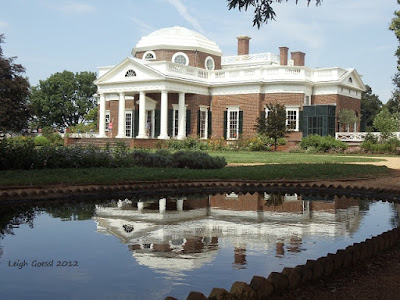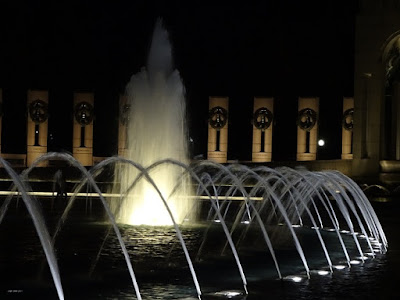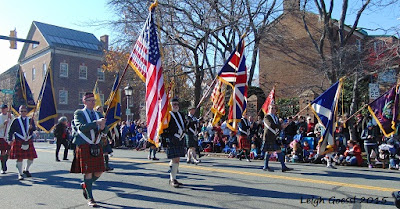Since the early 20th century, Monticello has been maintained as a historical landmark and has been open to tourists. The property is probably one of Virginia’s best-known landmarks.
 |
| Front entrance of Monticello/credit Leigh Goessl/All rights reserved |
Centuries ago, Jefferson had chosen Charlottesville as the location to build his new home. Today, it's a booming area and centered around the University of Virginia (UVA), the college of which Jefferson himself is the founder. There are also many vineyards and other fine attractions in the area if you're looking to take a day or weekend trip - or an off-shoot excursion - from the District.
Construction of Monticello
Construction of this grand house began in 1769 and was a work in progress that spanned more than 40 years. Jefferson was known as one of the first - and best - architects in America in his time. He took his time building his masterpiece which he referred to as “his essay in architecture”, according to the National Parks Service.
Touring the home and property, it's clear Jefferson took pride in his construction of what he must have viewed to be the ideal house. The build took on several different styles over the years as Jefferson changed things along the way. In spite of having changed his mind during construction to reflect newer styles, the final result is magnificent.
 |
| Image credit: Leigh Goessl/All rights reserved |
Many of the other grand homes of this period are restored to what is interpreted by what records are found at any given time, but this is often difficult since there is always tons of research that consistently entails new discoveries uncovered which can change a property's historical interpretation. (As an example, for years George Washington’s Mount Vernon was white, but in the 2000s researchers discovered the home was actually more of a beige color for the period they were interpreting, and a change was made to reflect accuracy).
However, in the case of Jefferson and Monticello, he took such meticulous records, the interpretation visitors see today appears to be pretty spot on. His documentation provided the future generations a very detailed history to follow.
The house was originally supposed to have 14 rooms (by the 1780s it still only had eight rooms), but by completion, rooms totaled more than 40 with 33 being in the house itself. In 1784 Jefferson had traveled to France on official business and spent a total of five years there. “Smitten with the new Neoclassical architecture that he saw,” Jefferson then made a number of changes to the design of his home to show this admiration of architectural style.
Jefferson lived in his masterpiece until his death in 1826.
Inside the Home
Of importance to Jefferson was his “book room” which is adjacent to his office, which connects to his bedroom. His library boasted a number of very large bookcases, showcasing his love of books. The books visitors see on their tour are not originals, but a large percentage of them reflect - or are reproductions of - the books he did actually have in his collection. (His original books are currently on display at the Library of Congress in Washington, D.C., as he’d sold his collection to the government to replace the books that had been lost when the British burned the U.S. Capitol during the War of 1812).
Overall, the interior of Monticello is remarkable. The upstairs is not part of the traditional tour, but there is a special tour that can be booked. I haven't yet had the pleasure of doing it during my visits.
The Property
Monticello (or “little mountain”), is indeed located on top of a mountain. The views are stunning, it’s no wonder he chose to build such a grand home on the property left to him by his father, Peter Jefferson. The gardens are spectacular and much restoration has been done on the property to bring it back to the way it looked during Jefferson’s time. There are flower and vegetable gardens are extensive (and to my understanding, many of them are planted with heirloom seeds).
 | |
|
- 18 varieties of apples
- 38 types of peaches
- 14 cherry varieties
- 12 pears
- 27 variations of plums
- 4 nectarines
- 7 kinds of almonds
- 6 apricots
- 1 quince
Adjacent to the majestic house is "Mulberry Row" which is where daily activities primarily took place. It had over 20 dwellings, workshops, and storehouses. The many rooms each had a singular purpose. Today visitors can walk through and see how plantation life was during Jefferson's time. There are also many artifacts that can be viewed. Jefferson's visions and innovations are clear both inside and outside of the grand structure.
 |
| Image credit: Leigh Goessl/All rights reserved |
Things to Know For a Visit
In addition to touring the home and gardens, on the property, there is a movie theatre, hands-on discovery center for the kids, museum, and much more. Additionally, a family cemetery is also located on the grounds and Jefferson’s grave is visible through the gates.
Throughout the property, there are many areas available to tour and learn the stories that took place during Jefferson’s time, including the Jefferson family and the history of the hundreds of both free and enslaved people that lived on the plantation. There are detailed family trees located in the museum and tells the stories of the people who lived at Monticello.
Other things to know:
- Peak season can be rather crowded. Usually, you can get tickets for a general tour, but if there are any special tours you do not want to miss, book these ahead of arrival.
- The second floor is not a part of the regular tour; this is a special tour with a separate fee.
- There is a child-friendly version of the house tour. The regular tour is OK for kids too, but the presentation of this one is geared towards the little ones.
- No photography is allowed inside Monticello or at the museum located on the property.
































